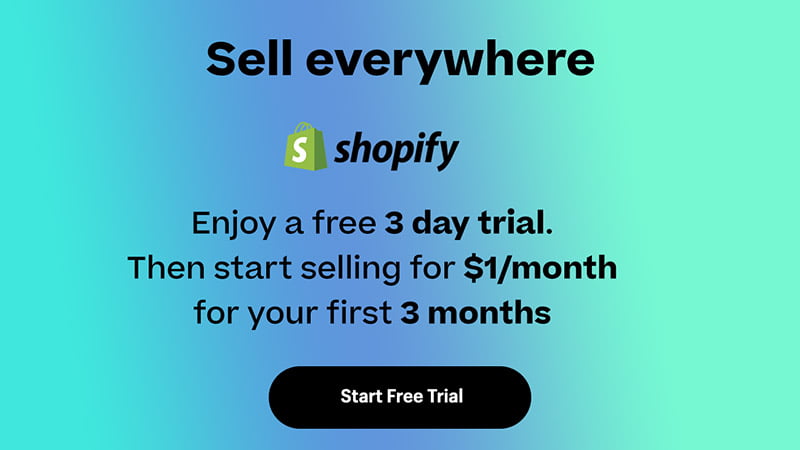Disclosure: We may earn a commission or fee from some of the links in our content. However, this does not affect our recommendations. Learn more.
After 10 years in the dropshipping game, I’ve tested just about every tool out there.
DSers used to be my go-to for AliExpress order automation — cheap, quick, did the job.
But times change. DSers is losing its Shopify integration.
And even before that, it started showing cracks — buggy syncing, slow support, limited supplier options.
If you’re serious about scaling your dropshipping store, you can’t rely on outdated tools.
So I tested all the top DSers alternatives — from budget-friendly AliExpress tools to fast-shipping platforms with US-based suppliers.
Here’s what I’d recommend instead.
TL;DR: Best DSers Alternatives in 2025
DSers is being phased out by Shopify, and it’s no longer reliable for fast fulfillment or scaling. This guide ranks the 11 best DSers alternatives based on speed, automation, and supplier quality. Top picks:
- AutoDS – Best all-in-one automation tool for scaling
- Spocket – Great for local suppliers + AliExpress flexibility
- Zendrop – Fast US shipping with private label options
- Sellvia – 1–3 day delivery from a US warehouse
- CJdropshipping – Global sourcing with custom branding
Each tool is tested, compared, and broken down by real-world use cases.
Whether you’re just starting out or scaling hard, there’s a better solution than DSers — and it’s in this list.
Why People Are Moving On from DSers
If you’ve been using DSers for a while, I know the feeling.
It worked. It wasn’t perfect, but it got the job done. One-click order fulfillment, synced inventory, low learning curve. Back when AliExpress was the main game in town, DSers was a solid choice — especially when it replaced Oberlo.
But in the last year or so, things started to shift. Orders would randomly go missing. Tracking numbers would fail to update. Support was hit-or-miss. And when Shopify announced it was officially cutting ties with DSers, that was the final nail.
Most people think switching platforms is about getting “more features.” It’s not.
It’s about making your store sustainable — something you can actually scale without burning out.
Here’s where DSers started falling short for me (and for a lot of serious sellers):
- Poor syncing — Orders stuck in pending, never sent to AliExpress
- Unreliable support — Took 48+ hours for basic responses
- No control over quality — Still tied to random AliExpress sellers
- Lack of innovation — Nothing new added in years that actually mattered
- Shopify dropping it — Once Shopify walked away, that was all I needed to see
If you’re still on DSers, you’ve probably already hit at least one of those walls. And you’re probably seeing the impact in your store — more customer complaints, slower order processing, and higher ad costs due to slower delivery.
The good news? There are better options.
Whether you’re sticking with AliExpress or switching to local suppliers, there are DSers alternatives that give you more control, speed, and scale.
Let’s break them down.
The Best DSers Alternatives (2025)
Each of these tools has been tested on live stores.
I’ve broken down what they do, how much they cost, and whether they work with AliExpress, local suppliers, or both.
1. AutoDS – All-in-One Automation for AliExpress & More
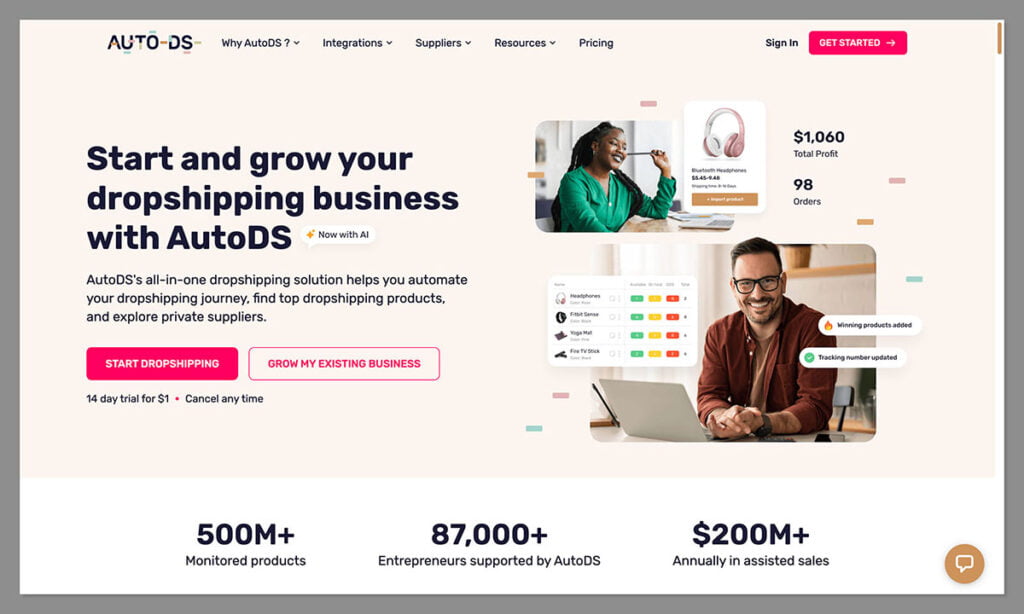
Suppliers: AliExpress, CJdropshipping, Walmart, Amazon, eBay, Alibaba, and more
Best For: Dropshippers looking for full automation across multiple platforms
I started using AutoDS when I needed to scale across multiple stores and suppliers — without spending my whole day inside spreadsheets and supplier dashboards.
What sets AutoDS apart isn’t just how many suppliers it connects to, but how smooth the automation runs once you plug it in.
AutoDS isn’t just an app. It’s a full-stack system that handles product research, importing, pricing, inventory management, auto-ordering, and tracking updates — all under one roof.
Here’s what I like about it:
Key Features Breakdown
| Feature | What It Does |
|---|---|
| One-Click Imports | Add products from 25+ suppliers instantly |
| Auto-Ordering | Automatically places orders when a customer buys |
| Tracking Number Automation | Pulls tracking from suppliers & sends to customers |
| Price/Stock Monitoring | Adjusts pricing and availability automatically |
| Product Research Tool | Helps you find trending, proven products |
| Custom Product Bundles | Combine multiple items into single offers |
| Multiple Store Connections | Manage eBay, Shopify, WooCommerce from one dashboard |
| Private Suppliers Access | Use vetted, faster, branded fulfillment options |
Real-World Benefits
I’ve used AutoDS on stores doing anywhere from 5 to 100+ orders a day.
The platform easily scaled with me.
Here’s where it really shines:
- No more manual orders. When you hit volume, manual fulfillment becomes a bottleneck. AutoDS kills that problem.
- Inventory sync that actually works. Products going out of stock? It updates in real-time. You don’t oversell.
- Access to multiple marketplaces. Want to dropship from Amazon or Walmart to eBay? It can do that too.
- Testing made easy. Use their research tool to find winning products with solid data — no guesswork.
Pros and Cons
Pros:
- Super scalable — works well for big stores
- 25+ supplier integrations (way beyond DSers)
- Excellent automation features
- Built-in product research tool
- Supports multiple platforms (not just Shopify)
Cons:
- Some features feel overwhelming if you’re new
- Not the cheapest — costs add up on higher plans
- Customer support can be slow during peak times
Pricing Summary
| Plan Type | Monthly Cost | Features Included |
|---|---|---|
| Starter | $29.90/month | 200 products, 1 store, basic automation |
| Advanced | $47.90/month | 1,000 products, up to 3 stores |
| Pro | Custom pricing | Enterprise-level needs, custom solutions |
Free Trial: Yes – 14 days on all plans
Hidden Costs: Some features like product importing credits or private suppliers may cost extra depending on plan
Final Take
If you’re tired of clunky tools and want one platform to run everything — AutoDS is the most complete DSers alternative out there.
You’ll get better control, faster processing, and more supplier flexibility.
Yes, it’s more complex than DSers — but that’s because it does more.
And once you set it up properly, it’ll save you hours each week.
Great for growing stores, even better if you’re managing multiple marketplaces.
2. Dropified – Built for Serious Scaling
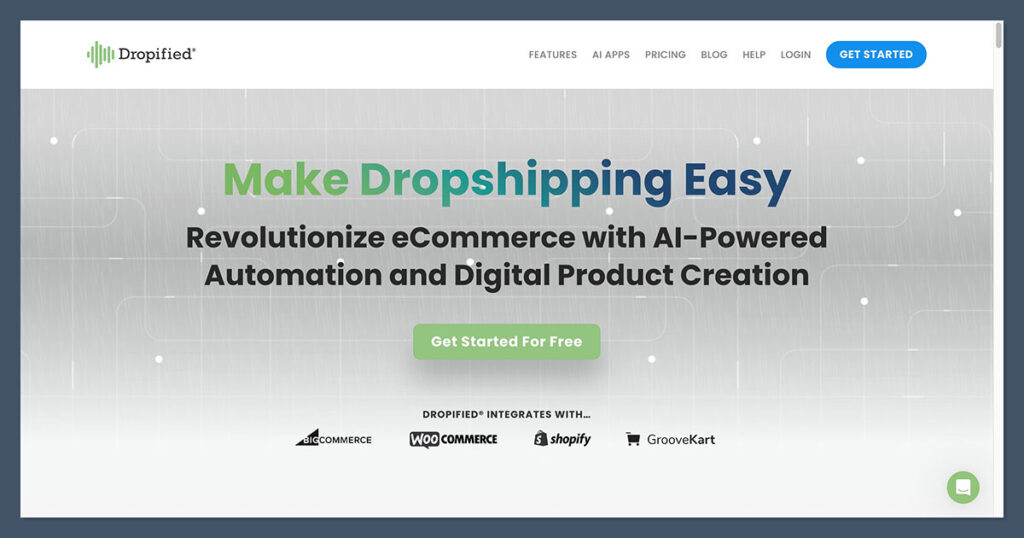
Suppliers: AliExpress, eBay, private/custom suppliers
Best For: Experienced dropshippers who want control, customization, and detailed automation
Dropified was one of the first tools I used when I started scaling past $20K/month.
Back then, most apps could barely handle basic order syncing. Dropified stood out because it was designed with high-volume sellers in mind — not just side hustlers testing a few products.
It’s a powerhouse. The dashboard feels a bit more old-school compared to newer apps, but once you know your way around, the amount of control you get is unmatched.
If you’re looking for serious automation, bundling, custom product options, and profit tracking, Dropified is worth a close look.
Key Features Breakdown
| Feature | What It Does |
|---|---|
| Bulk Order Automation | Fulfill hundreds of orders at once without manual input |
| Product Bundling | Combine multiple items into one sale with unified tracking |
| Profit Dashboard | Tracks revenue, COGS, and margins in real time |
| Custom Product Variants | Edit product titles, descriptions, variants before importing |
| Branded Invoicing | Add your logo and details to all order communications |
| Zapier Integration | Connect with 2,000+ other apps for advanced workflows |
| Private Supplier Support | Option to work with your own fulfillment partners |
Why I Like It
Dropified isn’t trying to be everything to everyone.
It’s made for intermediate to advanced dropshippers who want deeper control over how products are imported, listed, priced, and fulfilled.
What stood out for me:
- Bulk order processing: When you’re fulfilling dozens or hundreds of orders a day, you don’t want to click through each one.
- Profit tracking: Clean dashboards to see your exact ROI per product.
- Product customization: You can clean up messy AliExpress product listings before they hit your store — much better for branding.
- Bundling & upsells: Combine products into kits or bundles to raise your AOV without extra tools.
It’s the kind of platform you grow into — not one you outgrow.
Pros and Cons
Pros:
- Designed for serious dropshippers, not casual testers
- Profit tracking and analytics are built-in
- Excellent for product bundling and variant control
- Can connect to private or custom suppliers
- Supports Zapier for advanced workflows
Cons:
- Interface is clunky compared to newer apps
- Learning curve if you’re not familiar with advanced features
- Higher base price than beginner tools
- No support for non-English languages on listings out of the box
Pricing Summary
| Plan Type | Monthly Cost | Key Inclusions |
|---|---|---|
| Build | $47/month | Basic automation, 1 store, AliExpress fulfillment |
| Grow | $97/month | Advanced features, multiple stores, product bundles |
| Elite (Legacy) | $167/month | Private label rights, unlimited stores, full feature set |
Free Trial: Yes – 14 days
Special Access: Legacy plans sometimes offer lifetime pricing if you join during promos
Who It’s For
Dropified is best if you’ve outgrown tools like DSers and want something that lets you customise the way your store operates.
From tweaking product listings to building advanced funnels, Dropified puts control back in your hands.
It’s not the flashiest tool, and it’s not beginner-friendly — but if you’re already running a 5-figure store and want to optimise your margins, speed, and branding, it’s a great upgrade.
For me, it’s been a workhorse — especially when working with multiple suppliers and needing custom workflows beyond the basics.
3. Spocket – Flexible Tool for Both AliExpress & Local Suppliers
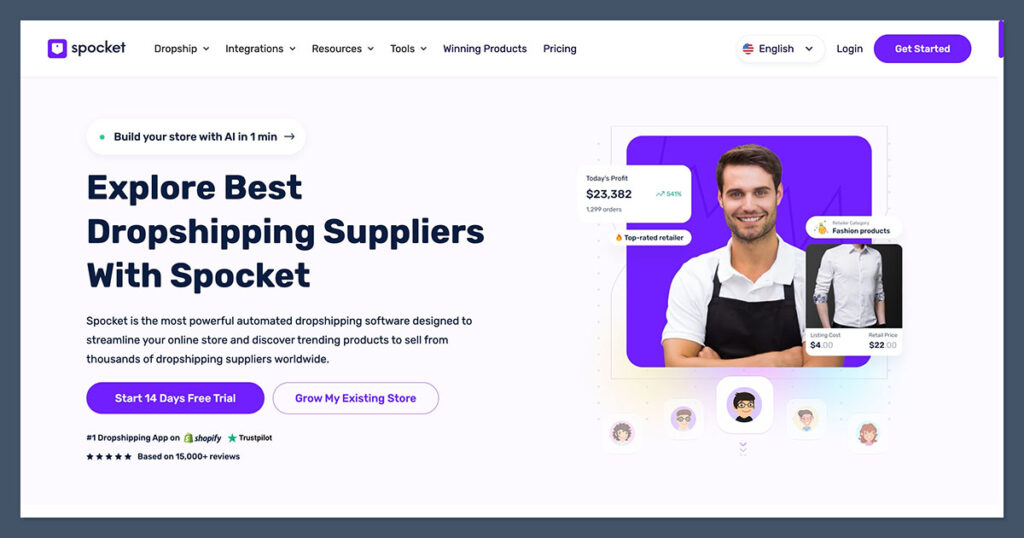
Suppliers: US, EU, Canada, Australia, and AliExpress (via AliScraper)
Best For: Store owners who want access to fast-shipping local suppliers, but still want the flexibility of AliExpress
Spocket is one of the more polished platforms out there. It offers a modern UI, strong integration with Shopify and WooCommerce, and a curated marketplace of products with local suppliers.
The big selling point is shipping speed — many of Spocket’s suppliers are based in the US or EU, which means customers can get their orders in 3 to 7 days instead of waiting weeks.
What makes Spocket unique is that it offers the best of both worlds.
You can use vetted local suppliers for faster delivery and still pull in AliExpress products using the AliScraper Chrome extension if you need to test trends or expand your catalog.
It’s not the cheapest tool, but if your goal is to build a branded store that competes on delivery time and quality, Spocket is worth considering.
Key Features Breakdown
| Feature | Description |
|---|---|
| Vetted Local Suppliers | Access US/EU-based suppliers with faster shipping |
| AliScraper Extension | Import products directly from AliExpress into Spocket |
| Real-Time Inventory Sync | Keeps stock levels updated automatically |
| Branded Invoicing | Add your store’s branding to customer orders |
| One-Click Import | Add products to your Shopify or WooCommerce store in seconds |
| Product Filtering | Sort suppliers by shipping origin, pricing, and profit margins |
| Order Tracking Integration | Real-time shipment updates for you and your customers |
My Experience with Spocket
When I needed to build a more reliable supply chain for a US-based niche store, I turned to Spocket.
I was tired of inconsistent shipping from AliExpress and refund requests piling up. What stood out immediately was how easy it was to filter suppliers who ship from within the US.
This shift alone reduced customer complaints significantly — and made my customer support team’s life easier.
Here’s what Spocket helped me improve:
- Shipping speed: Moving from 15–25 day shipping to 3–7 days made a huge impact on customer satisfaction.
- Supplier reliability: The suppliers listed on Spocket are vetted. You’re less likely to run into sellers who cancel orders or disappear after Chinese holidays.
- Brand perception: With faster fulfillment and branded invoices, customers started trusting the store more.
- Flexible sourcing: If a product wasn’t available locally, I could still pull in the AliExpress version using AliScraper to test demand.
Pros and Cons
Pros:
- Large directory of US/EU suppliers
- Built-in branded invoicing and fulfillment features
- Modern, user-friendly dashboard
- Works with Shopify and WooCommerce
- Can supplement with AliExpress products using AliScraper
Cons:
- Higher monthly cost compared to basic tools
- Supplier catalog is smaller than AliExpress
- Product prices can be higher due to local sourcing
- Not ideal if you rely only on trending, low-cost products
Pricing Summary
| Plan Name | Monthly Cost | Key Features Included |
|---|---|---|
| Starter | $39.99/month | 25 products, standard support, real-time sync |
| Pro | $59.99/month | 250 products, premium suppliers, branded invoicing |
| Empire | $99.99/month | Unlimited products, VIP support, bulk checkout |
Who Should Use Spocket
Spocket works best for store owners who care about delivery times, customer satisfaction, and brand positioning.
If you’re targeting customers in the US or Europe, Spocket allows you to compete with platforms like Amazon on speed — without needing to hold inventory.
It’s not for ultra-low-cost, high-volume AliExpress arbitrage. If that’s your model, there are cheaper tools.
But if you’re building a long-term brand and want to reduce refunds, speed up delivery, and create a more reliable customer experience, Spocket is a strong pick.
The ability to blend local and AliExpress fulfillment gives you flexibility that DSers and similar tools can’t match.
4. AliDropship – WordPress Plugin for AliExpress Stores

Suppliers: AliExpress only
Best For: Dropshippers who want full control and ownership using WordPress
AliDropship is a plugin designed specifically for WordPress users who want to run AliExpress dropshipping stores without paying recurring fees.
It’s not a hosted app like most Shopify-based tools — instead, it’s a self-hosted solution that gives you full control over your store, files, and infrastructure.
For sellers who prefer to work outside of subscription-based platforms and want 100 percent ownership of their business, AliDropship is a standout option.
It doesn’t have as many built-in automation features as AutoDS or Dropified, but the appeal here is different — it’s about customisation, control, and one-time pricing.
I’ve used AliDropship to build niche stores that don’t rely on third-party platforms.
The initial setup takes more work, but once it’s configured properly, you have a lean, cost-effective system that you fully own.
Key Features Breakdown
| Feature | Description |
|---|---|
| WordPress Plugin | Installs directly on your WordPress site |
| One-Time Payment | Pay once, use forever — no monthly fees |
| AliExpress Auto-Import | Pull products directly from AliExpress with all product details |
| Auto-Order Processing | Fulfill AliExpress orders with one click |
| Built-In Themes | Optimised ecommerce templates included |
| Pricing Automation | Markup rules to adjust prices based on supplier cost |
| Custom Store Option | Option to buy a fully built store from AliDropship |
What I’ve Learned Using AliDropship
AliDropship is ideal if you’re a technical user or willing to learn WordPress.
Unlike Shopify-based apps, you have full access to the backend of your site, giving you more flexibility over design, plugins, and hosting.
Here’s how it’s worked out in my own testing and client builds:
- Budget-friendly setup: For new stores, the low cost of ownership adds up. You avoid the recurring $30–$100 monthly subscriptions.
- WordPress flexibility: You can install any WordPress plugins — from SEO tools to custom checkout flows.
- Lifetime use: No worrying about monthly renewals or price hikes.
- Slower to scale: The plugin is solid, but you’ll need extra tools or manual processes once you start getting into high-volume orders.
This tool is better suited to long-term niche stores with moderate volume — not viral products or mass testing.
Pros and Cons
Pros:
- One-time payment — huge long-term savings
- Full control over your store (files, hosting, design)
- Excellent if you prefer WordPress over Shopify
- You own everything — no platform lock-in
- Built-in themes and plugins tailored for dropshipping
Cons:
- AliExpress only — no integration with other suppliers
- Slower setup and learning curve vs Shopify apps
- Requires separate hosting and WordPress knowledge
- Fewer automation features compared to modern SaaS platforms
- No built-in support for US/EU suppliers
Pricing Summary
| Product Type | Price | Details |
|---|---|---|
| AliDropship Plugin | $89 (one-time) | Lifetime license, all features included |
| Custom Store Build | From $299 | Team builds your store based on niche and branding |
Free Trial: No
Refund Policy: 30-day money-back guarantee on plugin
Who Should Use AliDropship
AliDropship is ideal for sellers who want to own their store outright and avoid paying monthly fees to platforms like Shopify.
If you’re comfortable with WordPress, or already using it, the plugin gives you a self-hosted alternative that still supports AliExpress product imports, auto-ordering, and automation.
That said, it’s not made for everyone. If you want to rapidly test products or scale paid ads, you might run into limitations.
But for stable niche stores with consistent product lines, AliDropship offers a low-cost, high-control way to build a reliable business.
It’s best for entrepreneurs who prioritise ownership and independence over having the most advanced features.
5. HyperSKU – Fast Global Shipping, AliExpress Alternative
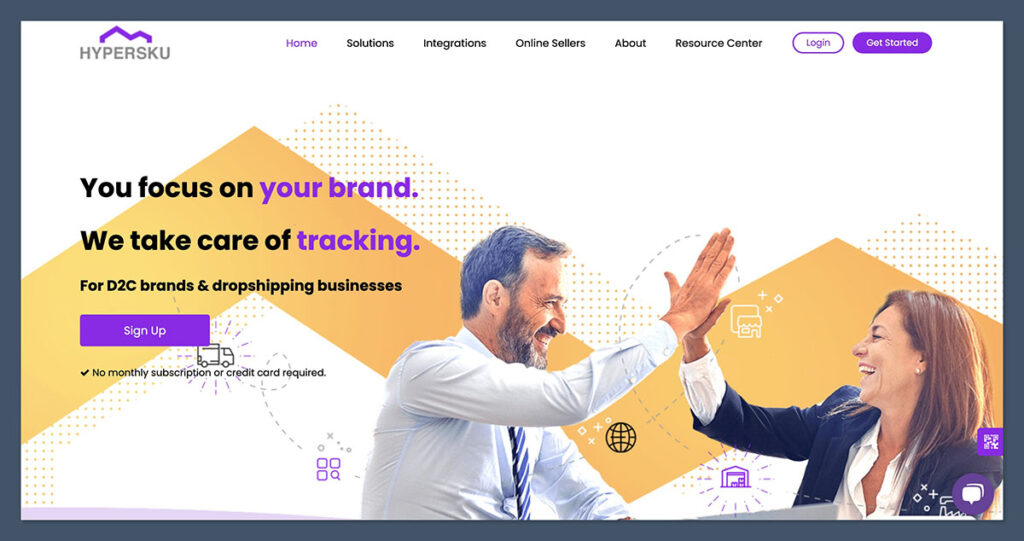
Suppliers: Private Chinese suppliers (not AliExpress)
Best For: Dropshippers who want better quality control and faster international shipping without switching to local warehouses
HyperSKU positions itself as a modern alternative to AliExpress-based fulfillment.
It connects sellers with private suppliers in China who offer faster shipping, better quality control, and more consistent inventory.
What makes it different is that it feels like working with a private agent, but without needing to hit high minimum order volumes.
I first tried HyperSKU when I needed to reduce shipping delays and complaints for one of my European stores.
The platform handled sourcing, fulfillment, and even some basic branding without needing a VA or manual back-and-forth with suppliers.
It’s ideal if you want better delivery times and quality than AliExpress, but you’re not ready to commit to a full-blown US warehouse setup.
Key Features Breakdown
| Feature | Description |
|---|---|
| Sourcing & Fulfillment | Products sourced from private Chinese suppliers |
| Faster Shipping Options | 7–12 day delivery available for most regions |
| Branded Packaging | Custom logos, inserts, packaging for brand-focused stores |
| One-Click Fulfillment | Orders synced directly from Shopify or WooCommerce |
| Built-in Dashboard | Track order statuses, inventory levels, and supplier communication |
| Multiple SKUs Support | Support for bundles and multi-variant items |
My Experience with HyperSKU
HyperSKU sits in that sweet spot between AliExpress and high-end fulfillment centres.
It’s fast, affordable, and a lot more stable than using random AliExpress sellers.
Here’s what made it a standout in my workflow:
- Reliable sourcing: They’ll find the same or similar products you’re selling on AliExpress, often at better prices.
- No ghosting: AliExpress sellers sometimes vanish. HyperSKU suppliers are part of the network — they stay accountable.
- Shipping you can actually track: Delivery is much more predictable, with tracking that updates quickly.
- Simple branding: You don’t need a private agent to start using branded packaging — just meet the MOQ.
It isn’t a one-click install like DSers or AutoDS, but it bridges the gap between DIY AliExpress fulfillment and full-scale sourcing teams.
Pros and Cons
Pros:
- Much faster shipping than AliExpress
- Better product and packaging quality
- Can scale without switching platforms
- Access to account managers for large volumes
- Works well for international fulfillment
Cons:
- No marketplace — products are sourced on request
- MOQ for branding options (usually 50–100 orders/month)
- Works only with Shopify and WooCommerce
- Manual product onboarding takes time in the beginning
Pricing Summary
| Feature | Cost |
|---|---|
| Platform Access | Free |
| Fulfillment Fees | Per product, varies by item and destination |
| Branded Packaging | MOQ applies, extra per order |
| Customer Support | Free (email + Skype account manager for volume sellers) |
Free Trial: Not needed — platform access is free
Hidden Fees: None — fulfillment pricing shown transparently per item
Who Should Use HyperSKU
HyperSKU is best for dropshippers who are sick of unreliable AliExpress sellers but aren’t ready to fully move to a US warehouse.
If you want faster shipping times, better margins, branded packaging, and a more stable supply chain, HyperSKU is a solid option.
It’s not plug-and-play like some of the others, but if you’re running a store that’s seeing traction — or if you’ve scaled and want to clean up fulfillment — this tool gives you more control without needing a sourcing team.
6. Sell The Trend – Product Research Meets Fulfillment
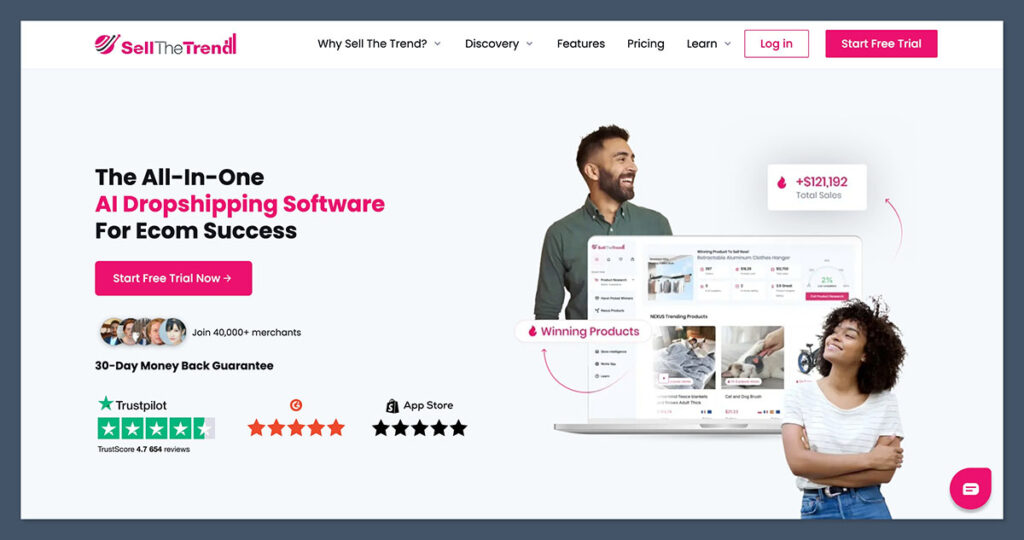
Suppliers: AliExpress, CJdropshipping
Best For: Beginners and mid-level sellers who want research, store building, and fulfillment in one place
Sell The Trend combines product discovery, automation, and fulfillment tools into one platform.
Unlike tools that only focus on order syncing or inventory tracking, this one starts at the very beginning — helping you find winning products based on real sales data, then automate everything else from product import to fulfillment.
I started using Sell The Trend when building niche stores where I needed to test a large number of products fast — without spending hours digging through AliExpress manually.
Their “NEXUS” product database is the core feature, showing you trending products, store analytics, and competition data.
This is one of the few tools that lets you go from product idea to running ads in under an hour.
Key Features Breakdown
| Feature | Description |
|---|---|
| NEXUS Product Explorer | Research tool showing trending products, sales data, and supplier info |
| Store Automation | Import products, set pricing, and fulfill orders from one dashboard |
| Video Creator Tool | Generate simple ad creatives automatically |
| Facebook Audience Builder | Find targeting ideas for ad campaigns |
| CJdropshipping Integration | Fulfill faster than AliExpress with global suppliers |
| Shopify + Woo Integration | Seamless sync between store and supplier |
What Makes It Unique
This tool is built for speed. If you’re running ad-driven stores and testing product after product, Sell The Trend is designed to keep you moving.
Here’s what I found helpful:
- Speed to launch: Find a product, create a video ad, and import it into your store in minutes.
- Data-backed research: Products come with store stats, order velocity, and margin calculators.
- Beginner-friendly: UI is clear and designed to guide you through every step — from finding to launching.
- Supplier options: If you want to move off AliExpress, it integrates with CJdropshipping for faster delivery.
It’s not as powerful as AutoDS or Dropified when it comes to deep automation, but it’s excellent for testing new products without wasting time or over-complicating fulfillment.
Pros and Cons
Pros:
- One dashboard for product research, fulfillment, and marketing
- Excellent for fast product testing
- Built-in video ad tools save a lot of time
- NEXUS database is constantly updated
- Includes both AliExpress and faster fulfillment options (CJdropshipping)
Cons:
- Less control over fulfillment details compared to HyperSKU or Dropified
- Limited supplier variety outside CJ and AliExpress
- Not ideal for stores that are scaling beyond 50+ daily orders
- Video ad tool is basic — may need extra editing
Pricing Summary
| Plan Name | Monthly Cost | Key Features Included |
|---|---|---|
| All-In-One Plan | $39.97/month | Full access to NEXUS, store automation, ads, integrations |
Free Trial: 7 days
Extra Costs: You pay separately for product fulfillment based on supplier prices
Who Should Use Sell The Trend
Sell The Trend is great for dropshippers who want a done-for-you system to test and launch products quickly.
If you’re running paid ads, hopping on trends, and validating products fast, this tool takes care of the boring stuff so you can focus on growth.
It’s also beginner-friendly.
Everything from importing products to creating ads is laid out clearly. That makes it perfect for someone looking to launch their first store — or run a general/niche store testing multiple products each week.
For me, it’s been a go-to tool when I’m building new stores fast and need to validate demand before investing more heavily in branding or infrastructure.
7. Zendrop – Fast US Shipping with Private Suppliers
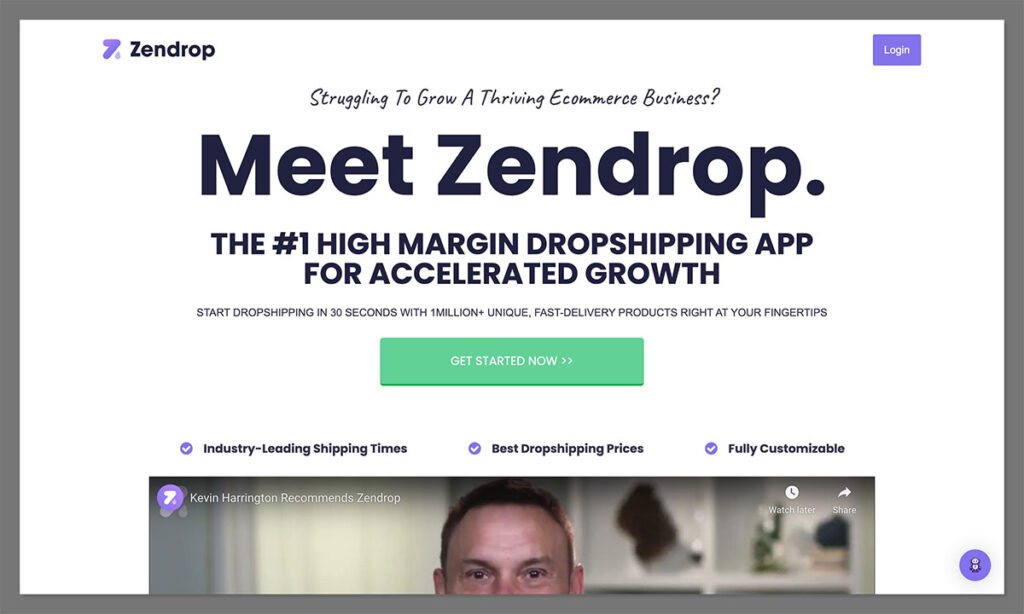
Suppliers: US and China warehouses
Best For: Sellers who want fast shipping, private labeling, and simplified automation without AliExpress hassles
Zendrop was built by dropshippers who got frustrated with AliExpress delays and supplier issues.
The platform was designed to simplify fulfillment, speed up delivery, and make it easier to build a brand around your store — all while staying within Shopify or WooCommerce.
It connects you to vetted suppliers with inventory stored in the US and China, giving you more control over fulfillment speeds and product quality.
You also get options like custom packaging, private labeling, and one-click order automation.
I’ve used Zendrop for several stores where speed was the priority — especially stores targeting US customers where AliExpress delivery times were killing conversion rates.
Zendrop dramatically reduced delivery times and refund rates, with far less support stress.
Key Features Breakdown
| Feature | Description |
|---|---|
| US-Based Fulfillment | Access to local suppliers and 3–5 day delivery in the US |
| Private Labeling | Add logos, inserts, and custom packaging |
| Auto-Order Fulfillment | Syncs with your store and fulfills orders automatically |
| One-Click Product Imports | Easily add new products from Zendrop’s catalog |
| Product Sourcing | Request products not listed in the marketplace |
| Training Library | Includes marketing tips, upsell strategies, and automation guides |
What Makes Zendrop Stand Out
There are two key reasons I recommend Zendrop:
- Speed: AliExpress was averaging 14–28 days. Zendrop cuts that down to 3–7 days (US-based stock) and 8–15 days (international).
- Branding: As soon as you’re doing steady volume, Zendrop makes it easy to add packaging, logos, or inserts — without dealing with sourcing agents or language barriers.
Here’s what I’ve noticed using Zendrop on multiple stores:
- Clean UI: Super easy to use — you can train a VA on it in 15 minutes.
- Sourcing support: If a product isn’t listed, they’ll source it within a few days.
- Better margins: Because of the faster delivery and support, you can charge more and refund less.
- Focus on quality: Less variation between batches compared to random AliExpress sellers.
Pros and Cons
Pros:
- Local fulfillment for faster delivery
- Clean dashboard and easy integration
- Private label options available
- Responsive customer service
- Good for scaling branded stores
Cons:
- Product catalog is smaller than AliExpress
- Free plan is very limited in functionality
- Can be expensive at higher order volumes
- Limited to Shopify and WooCommerce — no support for WordPress outside Woo
Pricing Summary
| Plan | Monthly Cost | Key Features Included |
|---|---|---|
| Free | $0 | 50 product imports, manual order fulfillment |
| Pro | $49/month | Unlimited orders, automation, branding options |
| Plus | $79/month | Priority sourcing, express shipping, advanced support |
Free Trial: 7 days on all paid plans
Extra Costs: Custom branding and express shipping carry additional charges per order
Who Should Use Zendrop
Zendrop is ideal for dropshippers who are ready to move away from slow AliExpress shipping and want to build a more professional, brand-focused business.
It’s not built for testing 50 products a week.
But if you’ve got winning products and want better control over quality, delivery, and customer experience — Zendrop gives you the infrastructure to do that without setting up your own warehouse or private agent.
The automation is reliable, the support is helpful, and the branding features give you a competitive edge if you’re serious about scaling.
8. Printful / Printify – Print-on-Demand Powerhouses
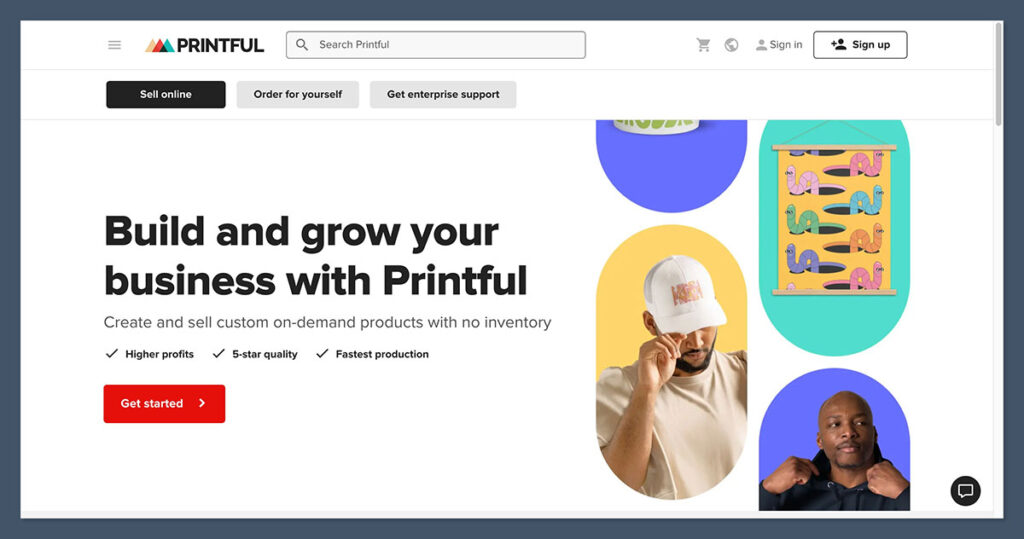
Suppliers: US, EU, and global print-on-demand partners
Best For: Sellers offering custom-designed products like apparel, accessories, and home decor
Printful and Printify are the two biggest platforms in the print-on-demand (POD) space.
While technically not traditional dropshipping tools, they work under the same model — no inventory, no upfront product costs, automatic order fulfillment, and global shipping.
Both platforms integrate with Shopify, WooCommerce, Etsy, and other platforms.
They allow you to design and sell everything from t-shirts and mugs to wall art, tote bags, and embroidered hats — all with your branding.
I’ve used both for niche clothing lines and merch stores.
While Printful is slightly more polished and has higher quality control, Printify often offers better pricing depending on the print provider you choose.
Key Features Breakdown
| Feature | Printful | Printify |
|---|---|---|
| Product Range | 300+ items | 750+ items (varies by print provider) |
| Branding Options | Custom labels, packaging, inserts | Limited — varies by provider |
| Print Providers | Printful-owned facilities | Network of global providers |
| Mockup Generator | Yes – includes lifestyle and flat mockups | Yes – basic but effective |
| Fulfillment Locations | US, EU, Mexico, Australia, more | Global, depends on provider |
| Pricing Control | Set retail price, margin, shipping | Same – full control |
How I’ve Used Them in Real Stores
Both platforms are solid. You don’t need to worry about sourcing, inventory, or packaging.
You upload a design, set a price, and they take care of everything once a customer places an order.
Where Printful excels:
- Higher consistency in product quality
- Branded packaging (available at higher volumes)
- Reliable delivery windows in US and Europe
Where Printify shines:
- Wider product selection
- Access to different suppliers for the same item
- Lower base cost on many products
Here’s what that looks like in practice:
- Printful is ideal for boutique stores with premium pricing.
- Printify is better if you’re focused on volume and competitive pricing.
Pros and Cons
Printful Pros:
- Top-tier product quality and packaging
- Fulfilled in-house — more consistent experience
- Excellent branding options
- Strong reputation and wide integrations
Printful Cons:
- Higher base product prices
- Slower fulfillment during peak seasons
- Limited supplier choice
Printify Pros:
- More product variety and flexibility
- Lower prices via multiple print providers
- Easy to scale multiple stores
Printify Cons:
- Quality control varies by provider
- Less control over branding
- Fulfillment speed depends on print partner
Pricing Summary
| Platform | Plan | Monthly Cost | Key Inclusions |
|---|---|---|---|
| Printful | Free | $0 | Full catalog, fulfillment, and mockup tools |
| Growth | From $24.99/mo | Discounts up to 20% + branding options | |
| Printify | Free | $0 | Full catalog, access to multiple providers |
| Premium | $29/month | Up to 20% discount on all products |
Free Trial: Not needed — both platforms are free to start
Extra Costs: Only pay when a customer buys — you set your own retail pricing
Who Should Use Printful / Printify
These platforms are perfect if you’re building a branded store around custom products — apparel, accessories, home decor, or merch. You don’t hold inventory, don’t deal with fulfillment, and don’t worry about returns.
Use Printful if you want to build a premium brand with consistent quality and great packaging.
Use Printify if you want more product options and lower costs but can live with supplier variation.
They aren’t ideal for fast-product testing, and margins are tighter than traditional dropshipping.
But for creators, influencers, or niche brands, they offer a great way to launch a store with minimal overhead and zero inventory risk.
9. Sellvia – US-Based Fulfillment for Speed
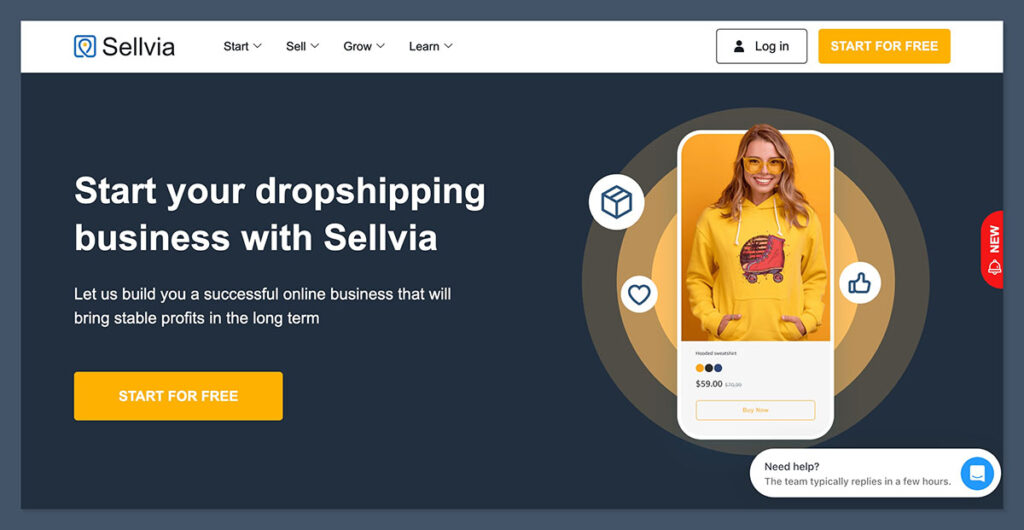
Suppliers: US-based warehouse and fulfillment center
Best For: Sellers targeting US customers who want 1–3 day delivery without managing inventory
Sellvia is a done-for-you dropshipping platform that focuses entirely on the US market.
All products are stored in its California warehouse, which means orders can be delivered in as little as 1 to 3 business days — a major upgrade over AliExpress or Chinese fulfillment models.
What makes Sellvia different is that it’s built for sellers who don’t want to deal with sourcing, importing, or finding private suppliers.
You simply pick products from their catalog, publish them to your store, and Sellvia takes care of the rest — including product descriptions, order fulfillment, and delivery.
I’ve used Sellvia for a few US-focused general stores.
The conversion boost from faster shipping was immediate. Abandoned cart rates dropped.
Customer complaints almost disappeared. And refund requests were cut by more than half.
Key Features Breakdown
| Feature | Description |
|---|---|
| US-Based Inventory | Products stored and shipped from California |
| 1–3 Day Delivery | Fastest shipping option on this list |
| Product Catalog | Ready-to-import product listings with photos and descriptions |
| Auto-Fulfillment | Orders are synced and fulfilled with one click |
| Marketing Materials | Includes ad creatives, copy, and product bundles |
| Private Store Option | Get a full store built for you by Sellvia’s team |
How Sellvia Performs in Real Stores
Speed is the number one reason to use Sellvia.
If you’re running a US-targeted store and tired of 14–20 day AliExpress shipping, Sellvia solves that problem overnight.
Here’s how it helped my stores:
- Shipping time improved drastically: Orders went from 15 days to 2–3 days, leading to better reviews and repeat purchases.
- No communication delays: Since everything is handled within the US, there’s no language barrier or timezone delays.
- Done-for-you catalog: Each product comes preloaded with polished photos, titles, and descriptions — a huge time-saver.
- Higher perceived value: You can price items higher because you offer fast shipping and US-based fulfillment.
If you want a no-hassle way to offer Prime-like delivery times in the US, Sellvia is one of the easiest tools to plug into your store.
Pros and Cons
Pros:
- Fastest delivery out of all DSers alternatives
- Full product catalog with ready-to-use content
- No sourcing or supplier management required
- Can build and manage stores for you
- Ideal for branded stores in the US
Cons:
- Only serves the US market — not suitable for international stores
- Smaller product catalog compared to AliExpress
- You can’t upload your own custom products — limited to their inventory
- Monthly cost required to access the catalog
Pricing Summary
| Plan | Monthly Cost | Key Features Included |
|---|---|---|
| Subscription | $39/month | Full catalog access, auto-fulfillment, marketing materials |
| Custom Store | From $299 (one-time) | Fully built branded store + Sellvia integration |
Free Trial: 14 days
Additional Costs: Fulfillment cost per product (usually $10–$25 depending on item)
Who Should Use Sellvia
Sellvia is a great fit if you’re selling to the US and want delivery times that match customer expectations.
Whether you’re running general stores or niche brands, the combination of speed, ready-to-go content, and hands-off fulfillment makes it a simple solution.
It’s not ideal for international sellers or high-volume product testers, but for long-term, branded ecommerce stores targeting the US, Sellvia helps boost conversion rates and customer satisfaction overnight.
10. CJdropshipping – Global Warehouses, AliExpress Alternative
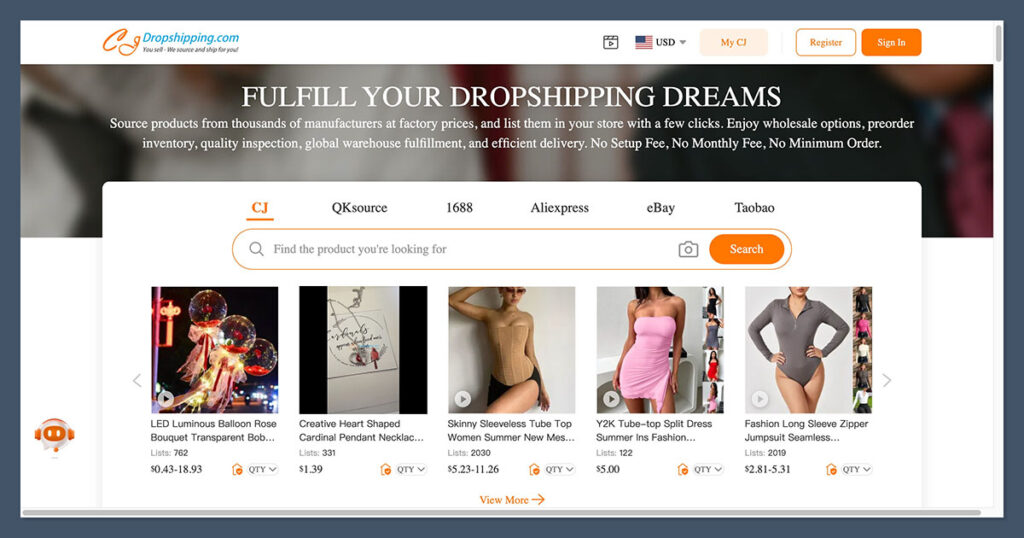
Suppliers: China + global warehouses (including US, UK, Germany, Australia)
Best For: Sellers who want access to a wide range of products, faster shipping, and better support than AliExpress
CJdropshipping is a full-service dropshipping platform that replaces many of the issues sellers face on AliExpress.
It offers product sourcing, automated fulfillment, custom packaging, and global warehousing, all within one platform.
What sets CJ apart is that it functions more like a hybrid between AliExpress and a private sourcing agent.
You can browse their product catalog or request a custom sourcing quote for items not listed.
And if you’re doing volume, they’ll negotiate better pricing, offer branding services, and route your products through local fulfillment centers for faster delivery.
I’ve used CJ with clients who wanted to switch off DSers but still keep access to a broad range of low-cost products — without compromising too much on shipping speed or quality.
Key Features Breakdown
| Feature | Description |
|---|---|
| Product Sourcing | Request any product to be sourced (including custom products) |
| Global Warehouses | Stock products in US, EU, or Asia for faster delivery |
| Auto-Order Fulfillment | Orders automatically synced and processed |
| Branding Services | Custom packaging, inserts, logos available at scale |
| Print-on-Demand Support | Supports both general dropshipping and POD products |
| Shopify/WooCommerce/More | Integrates with most major ecommerce platforms |
How It Performs in Real Scenarios
CJdropshipping gives you a lot of flexibility, but it comes with a bit more complexity than tools like Zendrop or Sellvia.
Here’s how it helped streamline fulfillment for mid-size stores I worked on:
- Faster shipping than AliExpress: For top-selling products, we moved stock into US or EU warehouses. That brought shipping down to 3–8 days.
- Custom branding: At 200+ orders/month, we were able to get custom boxes, inserts, and logos on packaging.
- Sourcing team was responsive: They usually respond within 24 hours with quotes and alternatives.
- Lower risk: With the CJ team involved in fulfillment, you’re less likely to run into issues with ghosted suppliers or poor-quality batches.
It’s an upgrade from DSers, especially if you’re growing and want more control — without hiring your own sourcing agent.
Pros and Cons
Pros:
- Huge product catalog + custom sourcing
- Global fulfillment network
- Custom branding and private labeling available
- Better support and accountability than AliExpress
- Handles both general products and print-on-demand
Cons:
- Slightly more complex UI than beginner apps
- Sourcing response times can vary
- Shipping times still depend on warehouse availability
- No native marketing tools or product research tools
Pricing Summary
| Feature | Cost |
|---|---|
| Platform Access | Free |
| Product Sourcing | Free to request |
| Fulfillment Cost | Per item, based on supplier quote + shipping |
| Branding Services | MOQ required, usually 200+ units/month |
| Warehousing | Free storage for 30 days (then charges apply) |
Free Trial: Not needed
Additional Costs: Only pay when orders are fulfilled — no monthly fee
Who Should Use CJdropshipping
CJdropshipping is ideal if you’re scaling and want more supplier reliability, faster shipping, and access to both standard and custom products — without leaving the dropshipping model.
It’s especially useful if you:
- Want to move winning products to local warehouses
- Need branded packaging
- Want one platform to manage product sourcing and fulfillment globally
If you’re ready to move beyond AliExpress without building a private agent setup from scratch, CJdropshipping is one of the most flexible and cost-effective DSers alternatives available today.
Final Verdict: Which DSers Alternative Should You Choose?
There’s no one-size-fits-all answer — the right DSers replacement depends on your products, shipping needs, and where you are in your business.
After working with dozens of clients and testing each of these tools myself, here’s what I’ve learned: the wrong tool creates bottlenecks.
Slow shipping, order errors, bad support — they hurt your customer experience and make scaling almost impossible.
So before you jump into any tool, here’s how I recommend picking the right one.
How to Choose the Right DSers Alternative (Based on Real-World Use)
1. Where Are Your Customers Located?
- If you’re shipping mostly to the US, tools like Sellvia, Zendrop, and Printful are your best bet — they offer faster, local delivery.
- If you serve global customers, look at CJdropshipping, HyperSKU, or AutoDS with international supplier networks.
2. How Important is Speed?
- If speed is critical (e.g. you’re running paid ads), use platforms with US or EU warehouses — like Sellvia, Zendrop, or CJdropshipping with warehousing.
- If you’re just testing and want the lowest costs, AliDropship or Sell The Trend will work — but be prepared for longer delivery times.
3. Do You Need Automation?
- Tools like AutoDS, Dropified, and Spocket offer advanced automation — perfect if you’re handling 50+ orders per day.
- For beginners, Sell The Trend and AliDropship keep things simple without overwhelming dashboards.
4. Do You Want Branding Options?
- If you’re building a brand, pick a tool that offers private labeling, custom packaging, and inserts — such as Zendrop, CJdropshipping, or HyperSKU.
- AliDropship and Sellvia offer limited branding out of the box, unless you’re working at scale.
5. How Much Can You Spend?
- If you’re on a budget, AliDropship is a one-time payment. CJdropshipping and HyperSKU also charge only per order.
- For full-feature platforms like AutoDS or Spocket, you’ll need to invest in monthly plans — but they save time if you’re running volume.
Extended Comparison Table: DSers Alternatives at a Glance
| Tool | AliExpress Support | Local Suppliers | Shipping Speed | Branding Options | Starting Price | Automation Level | Best For |
|---|---|---|---|---|---|---|---|
| AutoDS | ✅ | ✅ | 8–15 days (intl) | ✅ (via suppliers) | $29.90/month | High | Scaling multi-platform stores |
| Dropified | ✅ | Limited | 10–20 days | ✅ | $47/month | High | Advanced users, bundling |
| Spocket | ✅ (via extension) | ✅ | 3–7 days (US/EU) | ✅ | $39.99/month | Medium-High | Hybrid product sourcing |
| AliDropship | ✅ | ❌ | 14–28 days | Limited | $89 (one-time) | Medium | WordPress users |
| HyperSKU | ❌ | ✅ (China Direct) | 7–12 days (intl) | ✅ | Free | Medium | Better-than-AliExpress quality |
| Sell The Trend | ✅ | ✅ (CJ) | 10–15 days | Limited | $39.97/month | Medium | Product testing, beginners |
| Zendrop | ❌ | ✅ | 3–7 days (US) / 10–14 intl | ✅ | $49/month | High | Brand-focused US sellers |
| Printful | ❌ | ✅ | 2–5 days (POD) | ✅ (advanced tier) | Free | High | Custom POD products |
| Printify | ❌ | ✅ | 3–7 days (varies) | Limited | Free/$29 | High | POD at lower cost |
| Sellvia | ❌ | ✅ (US warehouse) | 1–3 days (US only) | Limited | $39/month | High | Fast shipping for US market |
| CJdropshipping | ✅ | ✅ | 5–15 days (intl) / 3–8 local | ✅ | Free | High | Global sellers + POD |
What I Recommend Based on Use Case
Here’s what I recommend based on where your store is now:
➤ If you’re just starting out:
- Go with AliDropship (if using WordPress)
- Or Sell The Trend (if using Shopify or Woo)
➤ If you’re testing and scaling fast:
- Use AutoDS — great balance of automation and supplier options
- Or Dropified if you want deep control and bundling
➤ If you want faster shipping:
- Zendrop or Sellvia for US-based fulfillment
- HyperSKU for better quality from China, without AliExpress delays
➤ If you’re building a long-term brand:
- Spocket if you want AliExpress + local supplier flexibility
- CJdropshipping if you need branding and global fulfillment
➤ If you’re in print-on-demand:
- Printful for consistency and quality
- Printify for more options and better margins
Final Thought
Picking the wrong DSers alternative won’t just slow you down — it’ll hit your margins, your brand, and your customer trust.
Take 15 minutes to figure out your actual needs: delivery time, automation, budget, and scale.
From there, match your tool to your stage — not your wishlist.
Use automation if you’re doing volume.
Prioritise speed if you’re getting complaints. And never sacrifice product control if you’re building a long-term brand.
Frequently Asked Questions
Why is DSers no longer supported on Shopify?
Shopify officially ended its partnership with DSers because it’s phasing out support for apps tied exclusively to AliExpress. Shopify is pushing for faster, more reliable fulfillment options that can keep up with customer expectations — especially in North America and Europe.
This move signals a shift in the industry. Dropshippers now need to use tools that offer either local suppliers, faster shipping, or deeper automation, which DSers was falling behind on.
If you’re still using DSers on Shopify, you’ll likely face compatibility issues or full disconnection soon — switching is a must.
Can I still use DSers with WooCommerce or WordPress?
Yes, technically you can still use DSers with WooCommerce, but that doesn’t solve the underlying issues — such as slow fulfillment, clunky syncing, and poor product quality due to reliance on random AliExpress sellers.
Even if you’re not on Shopify, it’s still worth switching to a better tool. You’ll get more control, faster delivery, and fewer support headaches.
If you’re using WordPress, a better option is AliDropship — it’s built specifically for WordPress and doesn’t charge monthly.
What’s the best free DSers alternative?
If you want to avoid monthly fees, your best options are:
- CJdropshipping – Free to use, pay only per order, with sourcing and branding included
- HyperSKU – No monthly cost, with faster shipping than AliExpress
- AliDropship – One-time payment (not technically free, but no subscriptions)
- Printful / Printify – For print-on-demand sellers, both are free to use and charge per order
That said, “free” tools usually come with tradeoffs in speed, automation, or catalog size. So it depends on your priorities.
Which DSers alternative is best for fast shipping?
For US-based customers, go with:
- Sellvia – 1–3 day shipping from California
- Zendrop – 3–7 day US shipping, custom branding options
- Printful / Printify – 2–5 day shipping on most POD products
For international orders with faster-than-AliExpress delivery:
- HyperSKU – 7–12 days
- CJdropshipping – 5–15 days (depends on warehouse location)
- AutoDS – If using suppliers with express options
Faster delivery cuts refund rates and makes your ads more profitable — so it’s one of the most important factors to consider.
Can I still fulfill AliExpress orders without DSers?
Yes — multiple tools still support AliExpress.
Here are the best alternatives for AliExpress fulfillment:
- AutoDS – Full automation + bulk ordering
- Dropified – Deep AliExpress integration
- Sell The Trend – Easy product imports + sync
- Spocket – Has a Chrome extension (AliScraper) to import from AliExpress
You’re not locked into DSers if AliExpress is still your main supplier. These tools work just as well — if not better.
What’s the best DSers alternative for beginners?
If you’re starting from scratch, you want something that doesn’t overwhelm you but still has the essentials.
Here are the best beginner-friendly picks:
- Sell The Trend – Great UI, built-in research tools, beginner workflows
- AliDropship – One-time fee, fully hosted WordPress plugin
- Spocket – Easy to navigate, works with both local and AliExpress suppliers
Avoid tools built for scaling (like Dropified or AutoDS) until you’re doing consistent volume — otherwise you’re paying for features you won’t use yet.
What if I want to brand my packaging — which tools offer that?
Branding is key if you want to build customer trust, increase perceived value, or compete with Amazon.
Here are the top DSers alternatives that support custom packaging, branded invoices, or inserts:
- Zendrop – Branded packaging and inserts (MOQ applies)
- CJdropshipping – Full private label options for sellers doing 200+ orders/month
- HyperSKU – Custom branding and packaging available with minimum volume
- Printful – Advanced branding options (labels, pack-ins) with Growth plan
- Spocket – Branded invoices available, but limited control beyond that
Branding usually requires some volume — most tools require 50–200 orders/month before offering full private label options.
Can I migrate products from DSers to another tool?
Yes — most platforms allow you to import existing products. Here’s how it usually works:
- Export your products or product feed (CSV or direct export) from DSers
- Use the import feature on your new tool (AutoDS, Dropified, Sell The Trend, etc.)
- Reconnect supplier links (especially for auto-fulfillment)
Some platforms also offer migration services or Chrome extensions that make this process easier — worth asking support before doing it manually.
Which DSers alternative works best for print-on-demand?
If you’re running a print-on-demand store, you should skip DSers-style platforms altogether and use POD-focused tools.
Best options:
- Printful – Best for high-quality products and consistent branding
- Printify – Best for variety and lower base cost (with Premium plan)
Both integrate with Shopify, WooCommerce, Etsy, and more — and automatically fulfill orders without manual input. You can focus on design and marketing, while they handle everything else.
Is it worth paying for a premium DSers alternative?
If you’re doing volume or want to scale, yes — absolutely.
Free tools are fine for testing, but they often:
- Slow you down (manual fulfillment, no bundling, no automation)
- Cost you more in refunds or delayed shipments
- Limit supplier flexibility or branding
Premium platforms like AutoDS, Spocket, and Zendrop can easily pay for themselves if you’re doing consistent volume. They save hours every week and create a better customer experience — which directly improves your profit margins.
Don’t pick the cheapest tool. Pick the one that gives you the infrastructure to scale without breaking your store.

